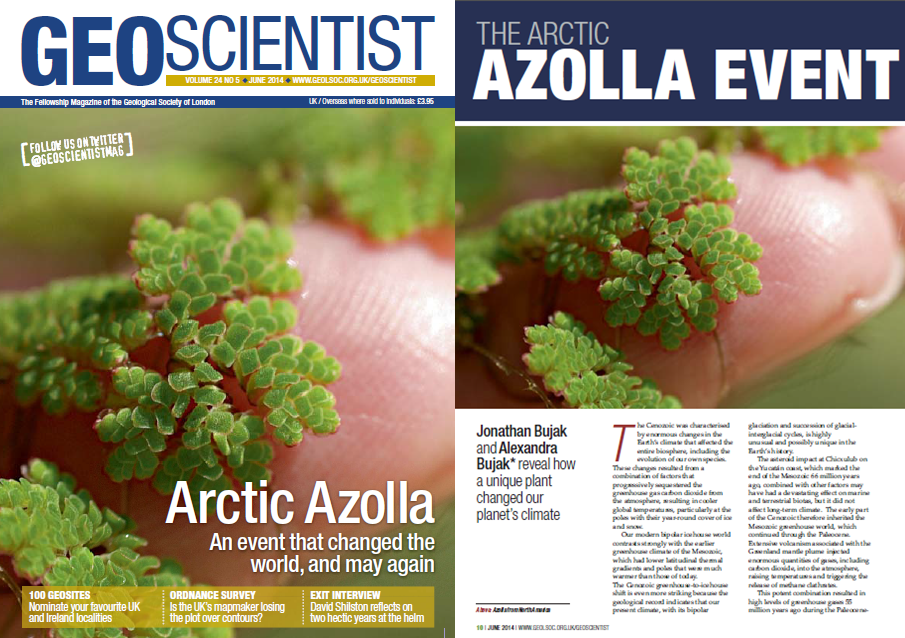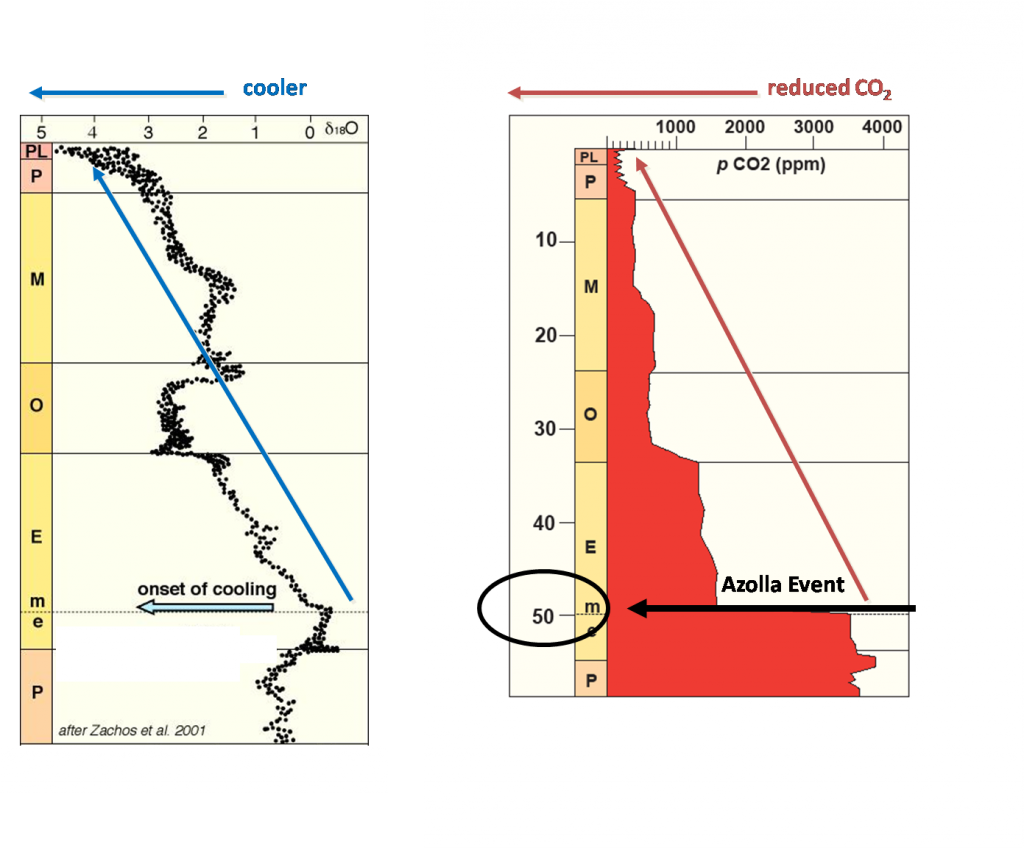One of the most remarkable discoveries about azolla came in 2004. A scientific expedition to the North Pole showed that this remarkable plant had a massive effect on the Earth’s climate 50 million years ago.
Reduced ice cover allowed the Arctic Coring Expedition (ACEX) drillship Vidar Viking to sail close to the North Pole and drill a scientific borehole in sediments of the Lomonosov Ridge beneath the Arctic Ocean seabed.
ACEX was a great success. It cored sediments that recorded events stretching back to the age of the dinosaurs 80 million years ago. This was a world with a greenhouse climate that had much warmer global temperatures than those of today, when turtles and alligators inhabiting lush forests a few hundred miles from the North Pole.
The greenhouse climate ended 50 million years ago when levels of the greenhouse gas carbon dioxide (CO2) suddenly fell. This resulted in an abrupt temperature fall and shift in the Earth’s climate from a greenhouse world, with its warm global temperatures, to our present icehouse climate with its permanent ice and snow at both poles.
Geologists have shown that our icehouse climate is very unusual compared to the Earth’s previous climatic history. So why do we now have an icehouse climate?
The ACEX cores provided the answer for the first time.
The 50 million year old sediments in the cores were composed almost entirely of azolla fossils, known as ‘the Azolla Interval’.

Left: ACEX Lomonosov Ridge drilling location. Right: The 50 million year old core filled with brown layers of azolla remains.

Specimen of fossil azolla (left) which is identical to those of the same age from the ACEX cores. Both have leaves (circled above in red) and tendrils (circled in blue) that are identical to those of modern azolla (right). The illustrated fossil is from the Green River Formation of Garfield County, Colorado, dated between 50.5 and 55.5 Ma (million years) and was kindly provided by Dr Ian Miller of the Denver Museum of Science.
But azolla is a freshwater plant. How could it have grown across the Arctic Ocean?
The ACEX scientists proposed a theory (Brinkhuis et al., 2006) which has been subsequently tested, with the results being published in various publications including Barke et al. (2012), Collinson et al. (2009), Bujak (2007) and Speelman et al. (2009).
Just over 50 million years ago the Arctic Ocean had a single marine opening to the south via the Turgay Strait (also known as the Turgai Sea). Then, the ocean became landlocked when the Turgay Strait closed 50 million years ago, resulting in a situation similar to today’s Black Sea.

The Arctic Ocean immediately prior to the Arctic Azolla Event (left) and during the event (right). Illustrations from Barke et al. (2012).
Large amounts of runoff from rivers due to the high greenhouse temperatures freshened the surface water of the Arctic Ocean, resulting in a shallow surface freshwater layer, or ‘plume’.
This freshwater surface layer allowed azolla to repeatedly spread across the ocean surface forming mats of vegetation during a succession of episodes called the ‘the Arctic Azolla Event‘. The event lasted for almost a million years from about 49.3 to 48.1 million years ago.
The ocean may have looked like this when viewed from the ancient Arctic shore:

Azolla mats covered large areas of the Arctic Ocean between 49 and 50 million years ago. Its precise extent is still uncertain.
The huge number of azolla plants sequestered enormous quantities of atmospheric CO2 which was converted directly into azolla’s biomass. As the plants died, they sank to the bottom of the Arctic Ocean where they were deposited as sediments that now form a layer beneath the Arctic Ocean.
During this time, the enclosed Arctic Ocean had restricted water circulation, resulting in an oxygen-poor ‘anoxic’ layer at the bottom, similar to today’s Black Sea.
The absence of bottom-dwelling (‘benthic’) organisms meant that the organic remains of azolla were not recycled back up into shallower water, but were deposited as the laminated layers of the Azolla Interval that were recovered by the ACEX cores.
The extent of the Azolla Interval is still uncertain, but we know that they occur beneath the Lomonosov Ridge because of their occurrence in the ACEX cores.
The CO2 sequestered by azolla caused atmospheric levels of CO2 to fall, triggering the initial shift from a greenhouse world towards our present icehouse climate, as featured on the cover of NATIONAL GEOGRAPHIC in 2005.

National Geographic featured the Arctic Azolla Event in May 2005, including illustrations of azolla (circled) and the greenhouse to icehouse climatic shift shown by the arrow.
in NATURE in 2006…..
as well as GeoExPro Magazine in 2007
Following the Azolla Event, processes such as mountain uplift and shifts in ocean currents caused atmospheric CO2 to fall even more. Progressive reduction of this greenhouse gas lowered temperatures further, particularly at the poles, leading to today’s unusual icehouse world with its repeated cycles of warmer interglacial and cold glacials (ice ages).
Mountain building and changing oceanography further reduced CO2 which caused temperatures to fall even more after the Arctic Azolla Event.
But levels of atmospheric CO2 are now increasing again due to industrialization that began in the mid 18th century, resulting in the emission of large volumes of greenhouse gases into the atmosphere.
Can azolla help?
We know that azolla had a massive impact on our climate 50 million years ago when it sequestered CO2 and moved the world’s climate away from a greenhouse state.
Could this amazing plant do the same today and help us reduce the danger of imminent man-made climate change?
The answer is yes.
It can help us reduce today’s atmospheric CO2 and also produce of livestock feed, food, biofertilizer and biofuel as by-products of the sequestration process, reducing the related threats of the Perfect Storm that we now face due to our population explosion.








